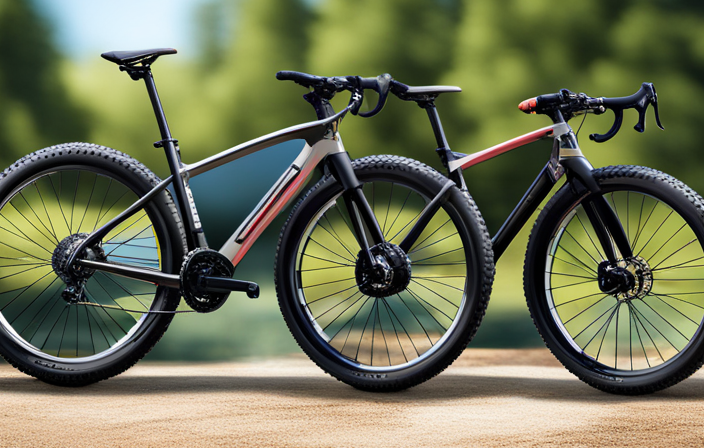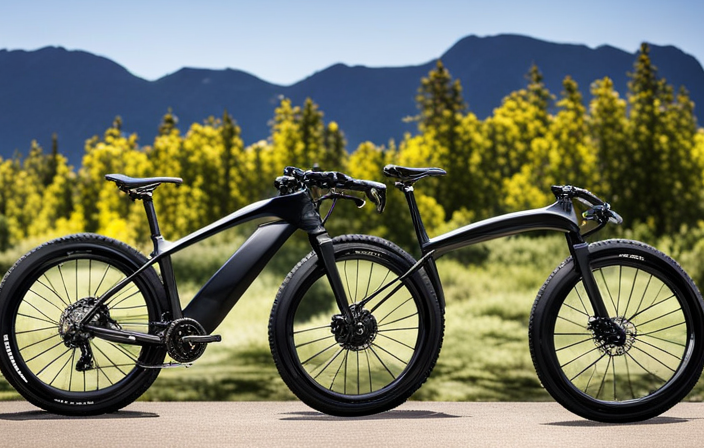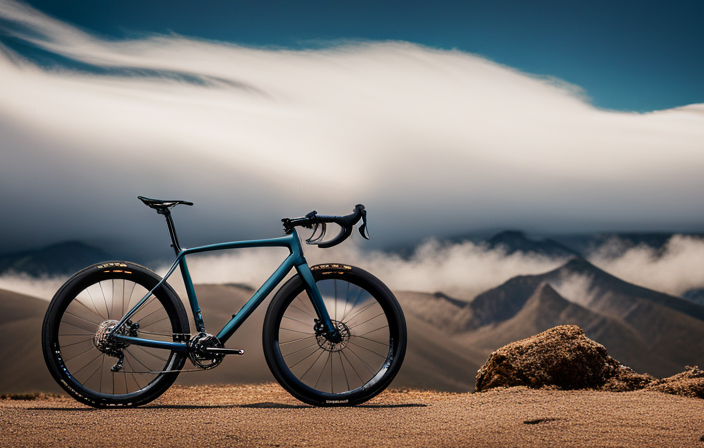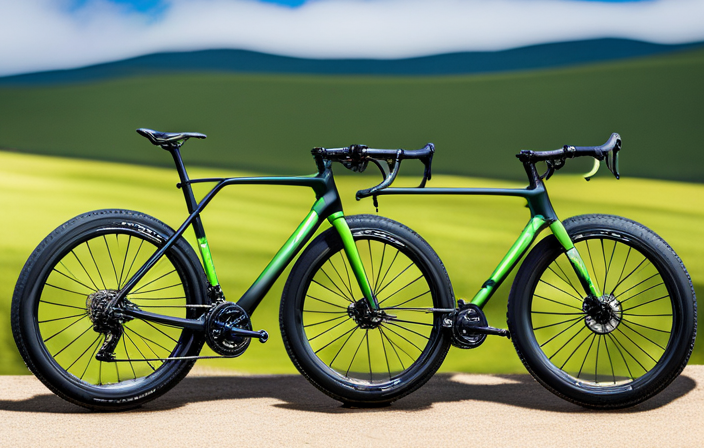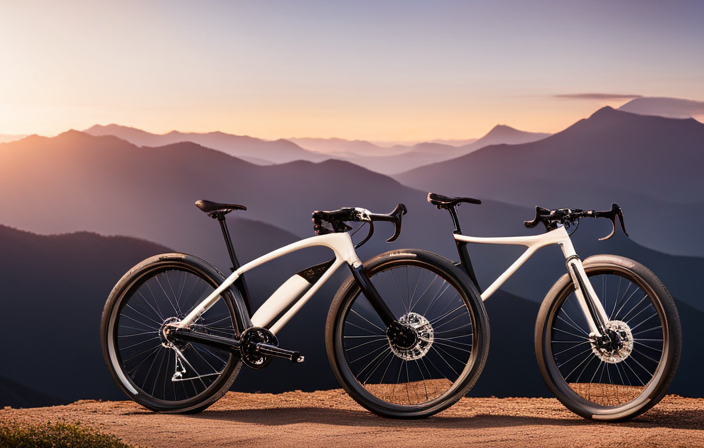Are you prepared to elevate your gravel biking to a higher level? One key item that can significantly improve your ride is the stem.
But with so many options available, how do you choose the right one for your gravel bike?
In this comprehensive guide, I will walk you through the process of picking a stem that perfectly suits your needs. From understanding the purpose of a stem to considering factors like length, angle, and material, I’ll provide all the knowledge you need to make an informed decision.
Let’s dive in!
Key Takeaways
- The stem is an important component of a gravel bike as it connects the handlebars to the fork steerer tube, controls direction and stability, and determines riding position and comfort.
- When selecting a stem for a gravel bike, factors to consider include riding style and goals, terrain preference, stem length and angle, and material options such as weight and durability.
- Compatibility and adjustability are crucial when choosing a stem, including considerations such as clamp size compatibility with handlebar diameter, handlebar compatibility with stem clamp size, desired height adjustment options, and compatibility with handlebar and steerer tube diameter.
- Other factors to consider when picking a stem for a gravel bike include aesthetics and brand reputation, price range and availability, the importance of reading reviews and seeking recommendations, and assessing stem performance and durability. It is also advisable to seek professional advice and consider budget constraints while balancing cost with quality and fit to make an informed decision.
Understand the Purpose of a Stem
You should understand the purpose of a stem before picking one for your gravel bike. The stem is an essential component that connects the handlebars to the fork steerer tube, allowing you to control the direction and stability of your bike. It also plays a crucial role in determining your riding position and comfort on the bike.
When considering stems for your gravel bike, it’s important to think about your riding techniques and bike fit. Are you someone who prefers a more aggressive riding style, with a lower handlebar position for better aerodynamics? Or do you prefer a more upright and relaxed position for long-distance rides? Understanding these factors will help you choose a stem that suits your needs.
Additionally, bike fit is crucial when selecting a stem. A properly fitted stem ensures that you have an optimal reach and height, preventing discomfort or strain in your back, neck, and shoulders during rides. It’s worth getting a professional bike fit or consulting with experts at a local bike shop to ensure you find the right stem size and angle.
Consideration of your riding style and goals is vital when choosing a stem for your gravel bike because it directly impacts how comfortable and efficient you’ll be on the trails or roads ahead.
Consider Your Riding Style and Goals
When determining the best option, take into account your preferred riding style and what you hope to achieve. Your riding technique plays a significant role in choosing the right stem for your gravel bike. If you have an aggressive riding style and enjoy pushing your limits on challenging terrain, a shorter stem may be more suitable. This will provide quicker steering response, allowing you to maneuver through technical sections with ease.
On the other hand, if you prefer a more relaxed and comfortable ride, a longer stem can offer better stability and control. Consider your terrain preference as well. If you frequently encounter rough or uneven surfaces, a shorter stem can help improve handling and responsiveness when navigating through obstacles. However, if most of your rides consist of long stretches of smooth gravel roads, a longer stem may enhance comfort by placing you in a more upright position.
By considering both your riding style and preferred terrain, you can choose a stem that complements your needs and goals on the bike. Once you have determined the correct stem length… [sentence transition]
Determine the Correct Stem Length
To find the right stem length for your needs, it’s important to consider factors such as riding style and preferred terrain. Determining the correct stem length is crucial in achieving optimal comfort and control on your gravel bike.
Several factors can affect the ideal stem length for each rider.
Firstly, your riding style plays a significant role in determining stem length. If you prefer a more aggressive riding position, with greater weight distribution over the front wheel, a shorter stem may be suitable. On the other hand, if you prefer a more relaxed riding position, with less weight on your hands, a longer stem may be preferable.
Additionally, the type of terrain you ride on should also be taken into account when determining stem length. For technical or steep descents where stability is key, a shorter stem can offer better handling and control. Conversely, for long endurance rides or smoother surfaces where comfort is paramount, a longer stem might provide more relief to your upper body.
By considering these factors affecting stem length – riding style and terrain preference – you can make an informed decision about which length will suit you best.
Once you have determined the correct stem length for your gravel bike based on these considerations, it’s time to move on to choosing the right stem angle.
Incorporating all aspects of bike fit will ensure that you are comfortable and efficient while riding.
Choose the Right Stem Angle
Consider the stem angle that best suits your riding style and terrain preferences for optimal comfort and control. When choosing a stem angle for your gravel bike, it is important to find the right balance between comfort and performance. The stem angle refers to the degree at which the stem rises or drops from the horizontal plane of the bike’s top tube.
To help you make an informed decision, take a look at this table showcasing different stem rise options:
| Stem Rise | Effect |
|---|---|
| High | Offers a more upright riding position and better visibility. Suitable for riders who prefer a relaxed and comfortable riding experience on rough terrains. |
| Neutral | Provides a balanced position suitable for various riding styles. It offers decent control without compromising comfort. Ideal for all-around gravel biking. |
| Low | Promotes an aggressive riding position with increased aerodynamics. Suitable for riders seeking speed and efficiency on smoother surfaces but may sacrifice some comfort. |
Finding the optimal stem angle for comfort and performance depends on your individual preferences as well as the type of terrain you will be tackling with your gravel bike. Once you have considered these factors, it’s time to evaluate material options in order to choose the most suitable stem for your needs.
Evaluate Material Options
Take a moment to explore the different material options available for your stem, so you can find the one that suits your needs and preferences.
When it comes to stems for gravel bikes, two common materials are carbon and aluminum. Carbon stems offer several advantages worth considering. First of all, they are incredibly lightweight, which can make a noticeable difference in overall bike weight. Additionally, carbon has excellent vibration-damping properties, which can help reduce road buzz and increase comfort during long rides on rough terrain. However, it’s important to note that carbon stems tend to be more expensive than their aluminum counterparts.
On the other hand, aluminum stems have their own set of pros and cons. One major advantage of aluminum is its affordability. Aluminum stems tend to be more budget-friendly compared to carbon options. They are also highly durable and can withstand impacts better than carbon stems. However, aluminum tends to transmit more vibrations from the road into your hands due to its stiffness.
When choosing between these two materials, consider factors such as weight and durability as well. By evaluating these material options thoroughly, you’ll be able to select the perfect stem for your gravel bike without compromising on performance or comfort.
Now let’s consider weight and durability when selecting a stem for your gravel bike…
Consider Weight and Durability
You should take into account the weight and durability of different materials when choosing a stem for your gravel bike. The material used in the construction of the stem can have a significant impact on both its weight and durability, which are two important factors to consider when making your decision.
When it comes to weight vs. performance, lighter materials such as carbon fiber or titanium can offer advantages. These materials are known for their high strength-to-weight ratios, meaning they can provide excellent performance without adding unnecessary bulk to your bike. However, it’s worth noting that these lightweight options may come with a higher price tag.
On the other hand, durability vs. cost is another aspect to consider. Aluminum stems are generally more affordable than carbon fiber or titanium ones and offer good durability. They can withstand harsh riding conditions and provide long-lasting performance at a lower cost.
In summary, assessing the weight and durability of different stem materials is crucial when selecting one for your gravel bike. Consider whether you prioritize lightweight performance or long-term durability based on your specific needs and budget.
As we move forward in our discussion about assessing clamp size compatibility, it’s important to keep these factors in mind.
Assess the Clamp Size Compatibility
To ensure a proper fit, it’s important to assess if the clamp size of the stem is compatible with your handlebars. The clamp size refers to the diameter of the part that attaches the stem to the handlebars. It is crucial to choose a stem with a clamp size that matches your handlebars’ diameter in order for them to securely fit together.
To help you understand how different clamp sizes correspond to various handlebar diameters, take a look at the following table:
| Clamp Size (mm) | Handlebar Diameter (mm) |
|---|---|
| 31.8 | 25.4 |
| 35 | 31.8 |
| 38 | 35 |
Assessing clamp size compatibility is an essential step in selecting the right stem for your gravel bike. By exploring different stem designs and shapes, you can find one that not only fits your handlebars but also suits your riding style and preferences.
Once you have determined the clamp size compatibility, you can move on to determining the handlebar compatibility and installation process without any issues.
Determine the Handlebar Compatibility
After assessing the clamp size compatibility, it is important to determine if the handlebar is compatible with the stem. One key factor to consider is the handlebar clamp sizes. Different stems have different clamp sizes, and it is crucial to ensure that your handlebar matches the clamp size of the stem you choose. The most common handlebar clamp sizes are 31.8mm and 35mm, but there are also other sizes available in the market.
In addition to the clamp size, another aspect to consider when determining handlebar compatibility is the stem height adjustment options. Some stems offer adjustable heights, allowing you to fine-tune your riding position for optimal comfort and performance. This can be particularly important for gravel riding, as it allows you to adjust your position based on terrain conditions.
Deciding on the desired height adjustment will depend on personal preference and riding style. Some riders prefer a lower, more aggressive position for better aerodynamics and control on technical descents, while others may opt for a higher position for increased comfort during long rides.
By taking into account both handlebar clamp sizes and stem height adjustment options, you can ensure that your chosen stem is compatible with your gravel bike’s handlebars and allows you to achieve your desired riding position without compromise.
Decide on the Desired Height Adjustment
In determining the handlebar compatibility for your gravel bike, we have established a foundation for selecting the perfect stem. Now, let’s delve into the next crucial factor: deciding on the desired height adjustment. This aspect plays a significant role in achieving optimal comfort and performance during your rides.
To assist you in visualizing the available options, I have prepared a handy table below that outlines different types of stem height adjustments and their corresponding benefits:
| Stem Height Adjustment | Benefits |
|---|---|
| Fixed | Provides stability and precise handling |
| Adjustable | Allows for customization and fine-tuning of riding position |
By considering these options, you can determine which type of stem height adjustment aligns best with your preferences and riding style. Additionally, it is essential to ensure that the chosen stem is compatible with your gravel bike’s specifications, including handlebar diameter and steerer tube diameter.
Once you have explored the various height adjustment possibilities as well as assessed stem compatibility, it’s time to evaluate the aesthetics and brand reputation of potential stems. This will further guide you in making an informed decision that perfectly suits both your functional requirements and personal taste.
Evaluate the Aesthetics and Brand Reputation
Consider evaluating the aesthetics and brand reputation of potential stems to guide you in finding a stem that aligns with your personal style and meets your functional requirements. When choosing a stem for your gravel bike, it’s important to take into account the price range and availability. Research different brands and compare their offerings to ensure you are getting the best value for your money. Additionally, exploring different color options and finishes can add a touch of personalization to your bike.
Brand reputation is also a crucial factor to consider. Look for well-established brands that have a history of producing high-quality products. Reading customer reviews can provide valuable insights into the performance and durability of specific stems.
In terms of aesthetics, choose a stem that complements the overall look of your bike. Some stems come in various colors or finishes, allowing you to match them with other components on your gravel bike.
Transitioning into the next section about reading reviews and seeking recommendations: By carefully considering aesthetics and brand reputation, you can narrow down your options before delving deeper into researching specific models through reviews and seeking recommendations from fellow cyclists.
Read Reviews and Seek Recommendations
To make an informed decision, it’s important to read reviews and ask for recommendations from fellow cyclists when looking for the right stem. Seeking recommendations is a great way to gather valuable insights from experienced riders who have already tested various stems. They can provide feedback on durability, performance, and overall satisfaction with different brands and models. Online forums, cycling communities, and social media groups dedicated to gravel biking are excellent platforms to seek these recommendations.
In addition to seeking recommendations, comparing prices is also crucial when selecting a stem for your gravel bike. Prices can vary significantly between brands and models, so it’s essential to do some research and compare options within your budget. Keep in mind that while price is an important factor, it shouldn’t be the sole determining factor in your decision-making process. Quality and performance should always take precedence over cost alone.
By reading reviews and seeking recommendations from fellow cyclists while comparing prices, you’ll gain a comprehensive understanding of which stems are highly regarded by the community. This knowledge will help you narrow down your options before moving on to the next step of consulting with a professional or bike shop for further guidance on selecting the perfect stem for your gravel bike without compromising quality or performance.
Consult with a Professional or Bike Shop
It’s advisable to consult with a professional or bike shop for expert advice on choosing the ideal stem for your off-road cycling needs. They can provide valuable insights based on their experience and knowledge in bike fitting. A bike shop specialist can assess your body measurements, riding style, and preferences to recommend the most suitable stem length and angle.
In addition to seeking professional guidance, it’s also beneficial to utilize online resources. Websites dedicated to gravel biking often have forums where riders discuss their experiences with different stems. Reading these reviews can give you an idea of which options are popular among fellow cyclists and whether they might be a good fit for you.
To help convey a deeper understanding of stem selection, here is a table comparing various factors that should be considered:
| Factor | Description |
|---|---|
| Stem Length | Determines reach and handling characteristics |
| Stem Angle | Influences handlebar height and rider positioning |
| Material | Aluminum, carbon fiber, or titanium options with varying attributes |
| Adjustability | Some stems offer adjustable angles or lengths for fine-tuning |
Considering your budget is essential when choosing a stem. However, it’s important not to compromise on quality or fit solely based on price alone.
Consider Your Budget
When you’re budgeting for your off-road cycling gear, keep in mind that the cost of a suitable stem should not be the sole determining factor. While it’s important to consider your financial constraints, there are other factors that should also be taken into account.
When choosing a stem for your gravel bike, it’s crucial to think about your riding preferences and how the stem will affect your overall riding experience.
Firstly, think about what type of riding you’ll primarily be doing. Are you planning on tackling more technical trails or sticking mainly to smoother gravel roads? This will help determine the length and angle of the stem that will best suit your needs. Additionally, consider if you prefer a more aggressive or relaxed riding position, as this will influence the height and rise of the stem.
Furthermore, take into consideration any physical limitations or discomfort you may have while riding. A well-fitted stem can help alleviate strain on your wrists, neck, and back. Investing in a higher quality stem with ergonomic features can greatly enhance your comfort and enjoyment on longer rides.
In conclusion, when choosing a stem for your gravel bike, it’s important to look beyond just price. Consider both your riding preferences and any physical limitations you may have to ensure that you select a stem that will optimize your performance and comfort on off-road adventures. If possible, test ride different stems to find one that feels right for you before making a final decision on which one to purchase.
Test Ride if Possible
When it comes to picking a stem for your gravel bike, considering your budget is important. However, there’s another crucial step that shouldn’t be overlooked – test riding if possible. I can’t stress enough how beneficial it is to actually get on the bike and feel how different stems perform.
During a test ride, you can assess the comfort level, handling capabilities, and overall performance of the bike with different stems. This firsthand experience allows you to make an informed decision about which stem will best suit your riding style and preferences.
To make the most out of your test ride, here are some tips:
-
Start with your current stem: Before trying out other options, take note of how your current stem feels. This will serve as a baseline for comparison.
-
Experiment with different lengths: Test out stems of varying lengths to see how they affect the bike’s responsiveness and handling.
-
Consider the angle: Adjusting the angle of the stem can also impact comfort and control.
By taking the time to test ride different stems and carefully evaluating their benefits and drawbacks, you’ll be well-equipped to make an informed decision about which one is right for you.
Now let’s move on to exploring ways to make that decision in our next section about making an informed choice.
Make an Informed Decision
To ensure you are making the best choice, take the time to gather all the necessary information and carefully consider your options.
When it comes to picking a stem for your gravel bike, there are a few factors to keep in mind. One of the most important is your riding position. The stem plays a crucial role in determining how upright or aggressive your riding position will be.
If you prefer a more relaxed and comfortable riding position, you may want to opt for a shorter stem that brings the handlebars closer to you. On the other hand, if you prefer a more aggressive and aerodynamic position, a longer stem that extends your reach might be more suitable.
Comfort level is another key consideration when choosing a stem for your gravel bike. A well-fitting stem can make all the difference in terms of overall comfort during long rides. It should provide adequate support and stability while allowing for natural movement and flexibility. Consider factors such as handlebar width, rise angle, and materials used in construction when evaluating different stems.
In conclusion, selecting the right stem for your gravel bike involves careful consideration of your preferred riding position and comfort level. By gathering all the necessary information and weighing your options, you can make an informed decision that enhances both performance and enjoyment on every ride.
Frequently Asked Questions
How do I know which stem length is right for me?
To determine the right stem length for me, I measure accurately by following a simple process.
Firstly, I place my bike in a level position and ensure the handlebars are straight. Then, I measure from the center of the headset top cap to the center of the handlebar clamp.
It’s important to note that stem length greatly affects bike handling. A longer stem provides stability at high speeds, while a shorter stem offers quicker steering response but may feel twitchy.
What is the difference between a positive and negative stem angle?
The difference between a positive and negative stem angle is crucial to consider when choosing a stem for your bike.
A positive stem angle angles upward from the steerer tube, while a negative angle angles downward.
The pros of a positive angle include improved comfort and handling, as it brings the handlebars closer and higher.
On the other hand, a negative angle can enhance aerodynamics but may sacrifice some comfort.
Ultimately, the choice depends on personal preference and riding style.
Can I use any handlebar with any stem?
Yes, handlebar compatibility with a stem is important. Not all handlebars and stems are compatible due to differences in clamp diameter and shape. It’s crucial to ensure that the handlebar matches the stem’s clamp size for a secure fit.
Additionally, consider stem angle adjustments to achieve your desired riding position. Stem angle adjustments can help fine-tune your bike’s handling and comfort by altering the height and reach of the handlebars.
What are the benefits of a lighter stem?
A lighter stem can have several benefits for a bike’s performance.
Firstly, it reduces the overall weight of the bike, making it easier to maneuver and accelerate.
Secondly, a lighter stem can improve the handling of the bike by reducing the amount of weight on the front end, resulting in more responsive steering.
Additionally, the material used in the stem can also impact performance, with carbon fiber stems offering better vibration damping and stiffness compared to aluminum ones.
How do I determine the appropriate clamp size for my stem?
To determine the appropriate clamp size for your stem, you can use measuring techniques. Measure the diameter of your handlebars where the stem will be mounted. Common clamp sizes include 31.8mm and 35mm, but it’s always best to check with the manufacturer for the specific requirements of your bike.
Using a caliper or tape measure, ensure an accurate measurement to ensure a proper fit and avoid any compatibility issues when selecting a stem for your gravel bike.
Conclusion
In conclusion, picking the right stem for your gravel bike is crucial for a comfortable and efficient riding experience. By understanding the purpose of a stem and considering your riding style and goals, you can narrow down your options.
Determining the correct stem length and angle, as well as evaluating material options, will further refine your decision-making process. Consulting with a professional or bike shop can provide valuable insight, while keeping your budget in mind.
And if possible, don’t forget to test ride different stems before making your final choice. Remember, finding the perfect stem is like finding that one-in-a-million partner who completes you on every ride!

